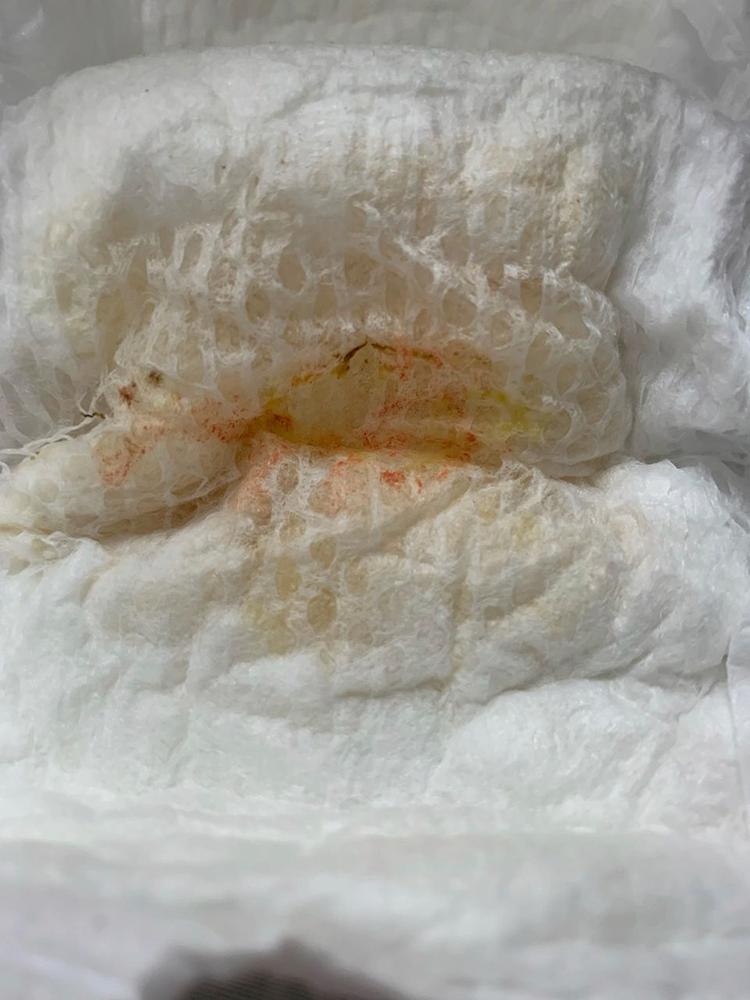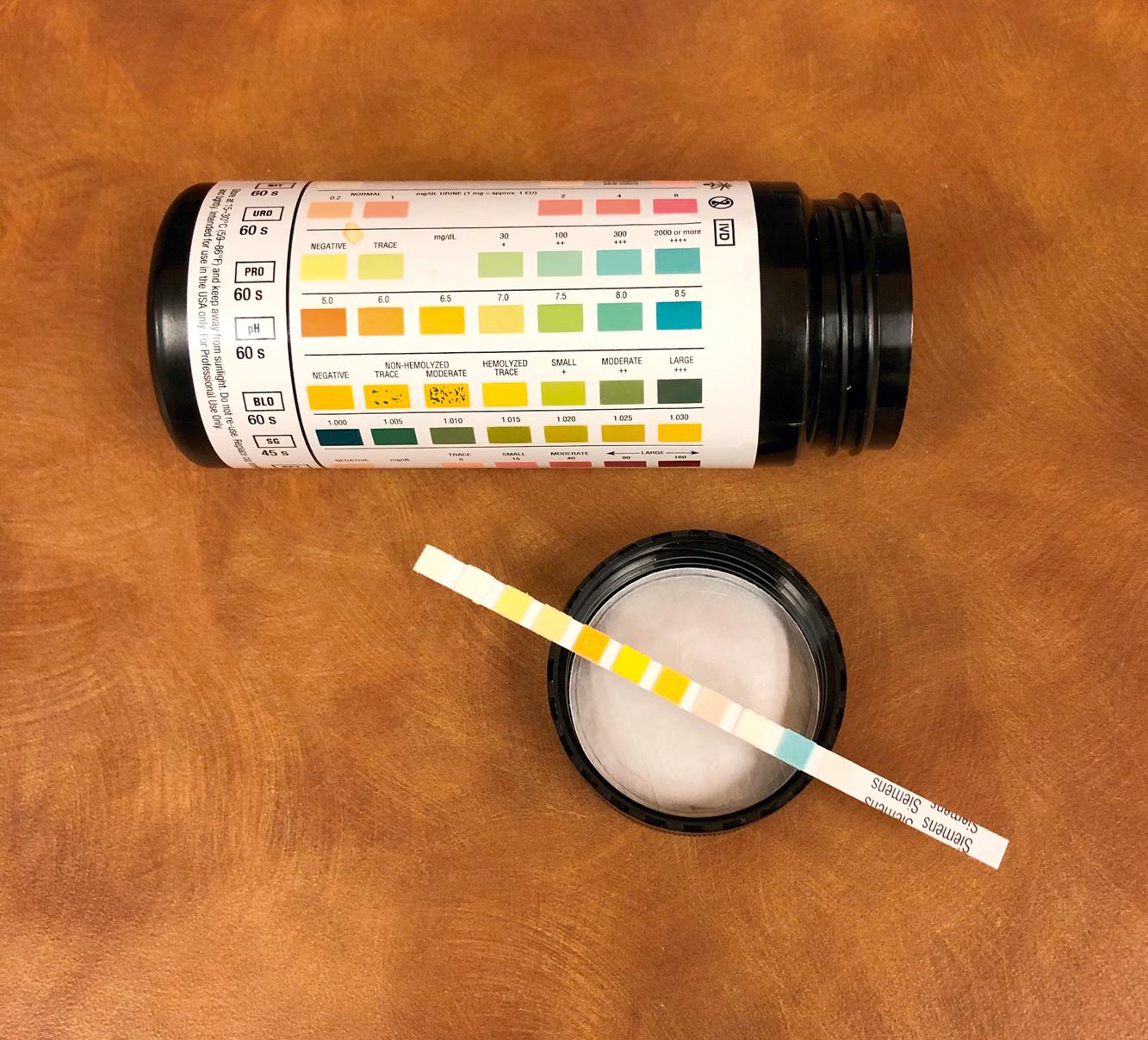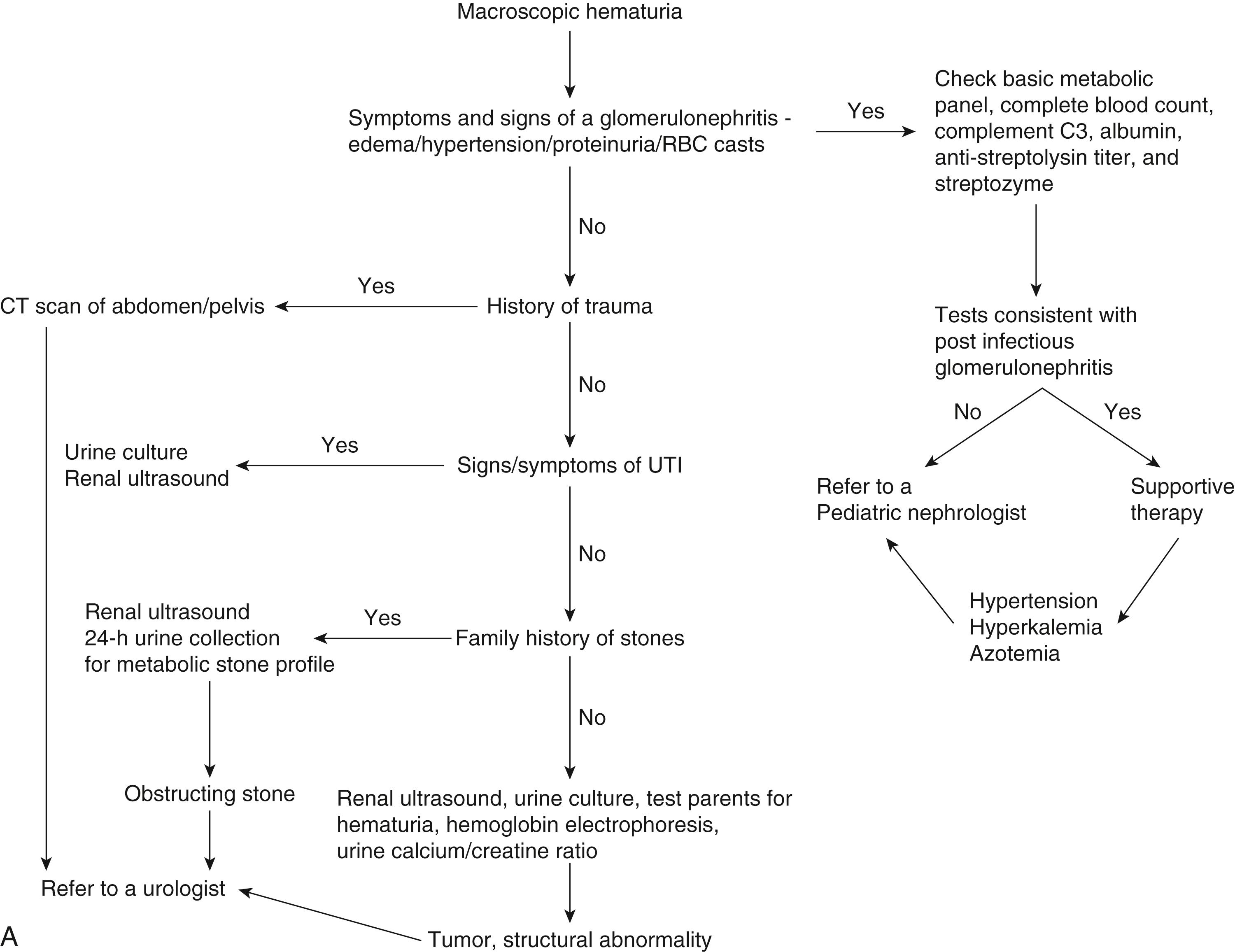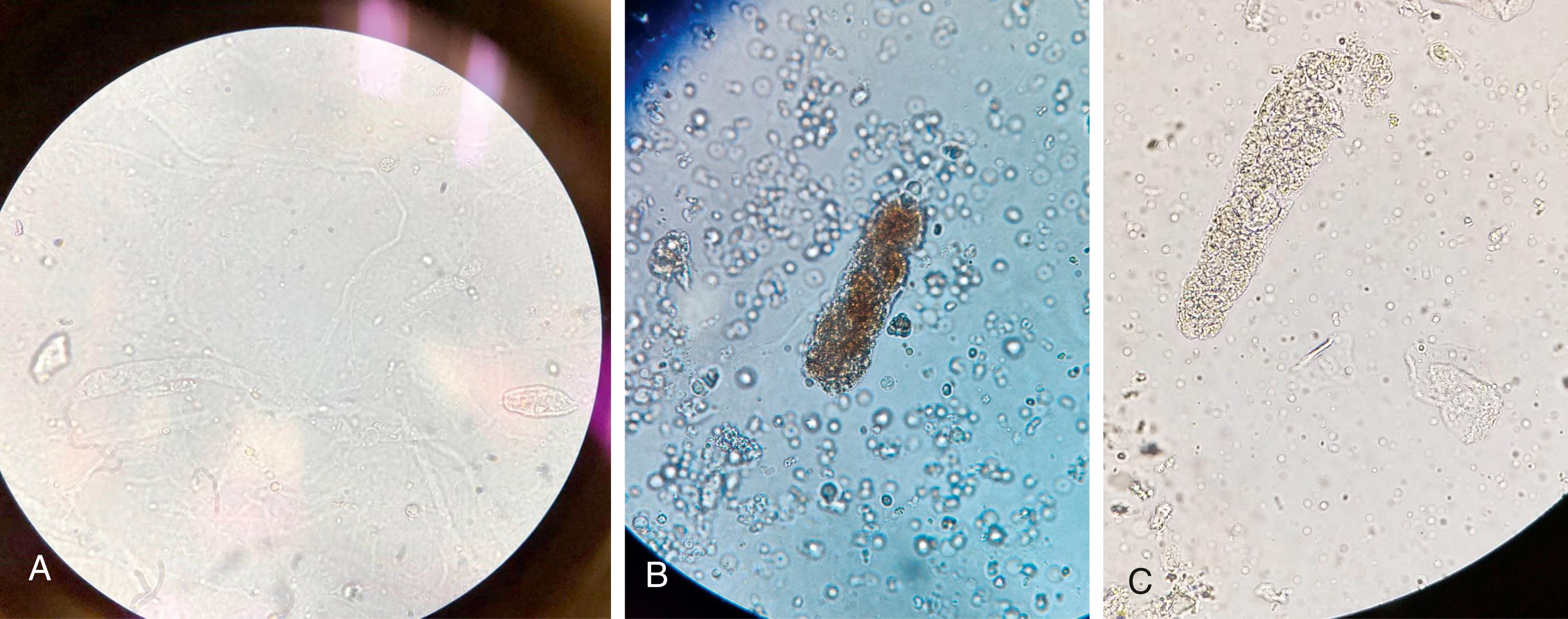Physical Address
304 North Cardinal St.
Dorchester Center, MA 02124
The manifestations of kidney and genitourinary disorders range from readily apparent gross structural abnormalities to subtle abnormalities of the urinary sediment. This chapter will review key history and physical findings, characteristic urinary findings, and updated diagnostic and radiographical studies of renal disorders encountered in both ambulatory and hospital settings.
The medical history and physical examination often provide clues implicating a renal or genitourinary disorder. Congenital, but often nonheritable, genitourinary disorders are diagnosed with increasing frequency during prenatal screening. Oligohydramnios and fetal compression signs reflect reduced urine production associated with some of these disorders and may result in early postnatal death because of pulmonary underdevelopment. “Cysts” in the kidney(s) on prenatal sonogram could represent various congenital anomalies of kidney and urinary tract (CAKUT) including cystic renal disease, dysplasia, polycystic kidney disease (PKD), and dilation of renal pelvis. A large placenta may be a telltale sign of congenital nephrotic syndrome (NS) of the Finnish type.
In the neonatal period, failure to urinate during the first 24 hours of life should prompt evaluation for obstruction of the kidneys, ureters, or bladder. A neonate with an abdominal mass born to a diabetic mother should be evaluated for renal vein thrombosis. Urinary tract anomalies, including vesicoureteral reflux (VUR) and megaureters, are common in infants and young children with history of urinary tract infection (UTI).
Infants with failure to thrive, lethargy, irritability or recurrent emesis may be manifesting signs of renal disease associated with metabolic acidosis and other electrolyte disturbances. On occasion, a renal disorder is discovered as part of an evaluation of extrarenal congenital anomalies. Family pedigrees may facilitate the diagnosis of congenital or heritable disorders such as cystinuria, cystinosis, hyperoxaluria, Alport syndrome, and PKD and thereby lead to a variety of preventive measures before children become symptomatic.
UTI should be a consideration in all febrile infants, particularly during the first 2 months of life, even in the presence of documented bacteremia, meningitis, or other sources of infection. Young children with true polyuria or polydipsia may have a renal concentrating defect including diabetes insipidus or salt-losing nephropathy such as renal dysplasia and nephronophthisis.
Hypertension (HTN) in infants is often caused by vascular diseases such as coarctation of the aorta or renovascular diseases like renal artery stenosis, renal vein thrombosis, and renal artery thrombosis. HTN is usually asymptomatic in children and adolescents, but if symptoms exist, the most common ones include headache, dizziness, nausea, vomiting, epistaxis, visual disturbances, and exercise intolerance. Primary HTN has become the most common cause in adolescents, often in association with obesity and metabolic syndrome. However, the presence of café-au-lait spots, neurofibromas, fibrous-angiomatous lesions of the skin, abnormal pulses, or bruits over the renal arteries or major vessels may point to a specific secondary HTN etiology.
Hematuria is one of the most common reasons children are referred to pediatric nephrology clinics. Specific aspects of the medical history such as the neonatal course, congenital heart disease, hematologic disorders including thrombotic or hemolytic disorders, antecedent or concurrent infection, rapid weight gain, joint symptoms, and concurrent rash may pinpoint the cause of hematuria. Obtaining detailed history such as actual color of urine (pink-tinged versus tea-colored), timing of gross hematuria (entire void versus terminal hematuria), and presence of blood clots can help to suggest the source of the blood within the urinary tract. Social history may suggest child abuse, trauma, or factitious disorder imposed on another as the cause. The presence of hematuria or renal failure in family members may suggest PKD, whereas a similar history together with neurosensory hearing loss may indicate Alport syndrome. Menarche is at times confused with hematuria. A history of direct or indirect trauma may explain the hematuria in the active and otherwise healthy adolescent.
A carefully performed urinalysis may expedite the diagnosis of various disorders and prevent the performance of unnecessary, costly, and invasive studies. Alternatively, the presence of cellular casts suggesting glomerulonephritis may guide further diagnostic studies. Routine urinalysis consists of three basic steps: gross inspection, dipstick screening, and microscopic examination.
On gross inspection, the color of urine may be described as clear, yellow, dark yellow, green, brown, tea colored, pink, clear red, grossly bloody, blue, or even black. Smoky, brown, or tea-colored urine is indicative of stagnated blood that has decomposed; the iron component has oxidized in the renal tubules. This commonly occurs in glomerulonephritis. Trauma, kidney stones, UTI, and strenuous exercise frequently result in frank hematuria with more pink or cranberry juice color. In the absence of hematuria on dipstick screening, numerous natural chromogens and vitamins found in foods, dyes, or medications may alter the normal yellow-amber color of urine imparted by the hemoglobin breakdown product, urochrome ( Box 14.1 ).
Drug and food ingestion
Aminopyrine, chronic mercury or lead, benzene, phenolphthalein, phenytoin, carbon tetrachloride, sulfonethylmethane, dinitrophenol, anthocyanin, azo dyes, carotene in carrots, betacyanin in beets, vitamins, blackberries, chloroquine, deferoxamine mesylate, ibuprofen, methyldopa, nitrofurantoin, phenazopyridine, rifampin, Ex-Lax, rhodamine E, sulfasalazine, Serratia marcescens, urates (red diaper syndrome)
Disease associated
Hemoglobinuric disorders, alkaptonuria, homogentisic aciduria, melanin, methemoglobinemia, tyrosinemia, obstructive jaundices
Drug and food ingestion
Alanine, resorcinol, thymol, phenazopyridine (Pyridium), rifampin, warfarin, laxatives, rhubarb
Pseudomonas infection, methylene blue, indicanemia, Hartnup disease, porphyria, drugs (propofol, metoclopramide, cimetidine)
Myoglobinuric disorders, hemoglobinuric disorders, asparagus, B vitamins
Hartnup disease, tryptophan malabsorption (indigotin, or indigo blue excretion)
Most importantly, one must exclude several medical disorders associated with pigmenturia and chromogens that may influence urine color. Yellow-brown urine may be seen in obstructive jaundice and is due to oxidation of bilirubin to biliverdin; porphyria and urinary porphyrins produce a red urine color; multiple disorders leading to myoglobinuria produce a clear red-brown color; chronic lead or mercury poisoning can also result in red urine color; and conditions leading to hemoglobinuria cause the urine to turn dark brown. Several special conditions in infants and children include the following:
Red diaper syndrome: a benign condition from uric acid supersaturation or overgrowth of Serratia marcescens ( Fig. 14.1 ).

Black diapers or undergarments: urine color turns black to brown on exposure to air. This condition is known as alkaptonuria and results from a defect in the enzyme homogentisate 1, 2-dioxygenase, which degrades tyrosine, leading to tissue accumulation and high urinary excretion of the tyrosine byproduct homogentisic acid.
Blue diaper syndrome: this occurs in Hartnup disease (neutral aminoaciduria) and is also seen in tryptophan gastrointestinal malabsorption syndrome, in which indigo blue is excreted in the urine.
Each small square on the urine dipstick is chemically engineered to be sensitive, specific, and cost-effective for the substance it detects ( Fig. 14.2 ). However, dipstick testing can result in false-positive results leading to unnecessary evaluation. It may also miss significant renal pathology that is not associated with hematuria or proteinuria. Urine dipstick squares include:
The hematest square detects free hemoglobin released after lysis of urinary erythrocytes by the o-toluidine reagent. The test is highly sensitive and detects myoglobin.
Screening for proteinuria via dipstick relies on change in the color of the tetrabromophenol blue reagent and is particularly suitable for detection of albumin. Hence, this test may miss low-molecular-weight (LMW) proteinuria resulting from systemic overproduction or due to insufficient reabsorption in children with tubulopathies.
A positive nitrite test is highly specific for UTI and results from conversion of dietary nitrates to nitrites by bacterial pathogens.
The leukocyte esterase test is also useful in diagnosing UTI and is mediated by the release of this enzyme from neutrophils. In adults and older children, but not in infants, the presence of both positive nitrite and leukocyte esterase tests has both positive and negative predictive values that approach 100%.
Ketones may be detected in the setting of starvation or diabetes mellitus.
Specific gravity (SG) is a measure of the total solute in urine and depends on both the concentration and molecular weight of solutes. In healthy individuals, SG of 1.010 corresponds to 400 mOsm/kg H 2 O, 1.020 equals 800 mOsm/kg H 2 O, and 1.030 equals 1200 mOsm/kg H 2 O. Children with dehydration or those receiving hyperosmolar radiocontrast media may have SG exceeding 1.030. Low SG may be found in healthy children with high fluid intake or in pathological conditions such as tubulointerstitial disorders and inadequate secretion of antidiuretic hormone.

Examination of the urine sediment begins with centrifugation of 10 mL of freshly voided urine for 5 to 7 minutes at 3000 rpm. Such standardized preparation enables semiquantitative comparison of sequential samples and often provides invaluable clues concerning the etiology of numerous renal disorders as well as the anatomic location of hematuria or pyuria. Specific urine microscopy findings will be reviewed in detail in the respective renal conditions covered in this chapter. Dysmorphic RBCs, best seen in uncentrifuged urine with phase microscopy, are usually of glomerular origin as opposed to urologic origin. White blood cells (WBCs) coated with antibody tend to become agglutinated or clumped. Such clumped WBCs are indicative of pyelonephritis or interstitial (IS) nephritis rather than cystitis. The presence of several tubular epithelial cells is abnormal.
Formation of urinary casts is aided by diminished urine flow, high urinary solute concentration, and the hyaline matrix of plasma- and tubule-derived protein in which cells become embedded. Hyaline casts form on polymerization of Tamm-Horsfall glycoprotein, which is a well-characterized molecule uniquely found in the ascending limb of Henle and distal convoluted tubule. Small quantities of hyaline casts may be found in healthy individuals, but larger numbers of hyaline casts or those containing cellular components are considered pathologic. Muddy-brown granular or tubular epithelial cell casts are seen in acute tubular necrosis (ATN). Granular casts form from disintegration of cellular elements. These are always pathologic and are found in most cases of glomerulonephritis. Wide casts may derive from dilated tubules, which occur in individuals with advanced renal disease.
Crystals are best identified in fresh urine that is of near body temperature. Uric acid crystals and urates are found in urine with a pH less than 6.5, whereas phosphates precipitate in urine with a pH greater than 6.5. Both urates and phosphates tend to precipitate when the urine specimen is refrigerated. Crystals may be found in the urine of healthy individuals, patients with urolithiasis or hyperuricemia, or those with a specific drug intake or poisoning (ethylene glycol). Flat hexagonal crystals are pathognomonic of cystinuria.
Because of the many conditions associated with persistent hematuria in children, several algorithms have been devised to aid in the systematic evaluation of this condition ( Fig. 14.3A–C ). History and clinical symptoms may point toward trauma, viral or bacterial cystitis, drug-induced hematuria, glomerulonephritis, or other causes. Detection of the most common causes of hematuria including glomerulonephritis or UTI can be readily achieved by the finding of cellular casts in an examination of the urinary sediment or by appropriate bacterial cultures. Moreover, heme positive urine dipstick but absence of RBCs on urine microscopy suggests the diagnosis of rhabdomyolysis or hemolytic disorders. Well performed urine dipstick and microscopy is invaluable in determining the etiology of hematuria by guiding the focus of the investigation to abnormal excretion of urine metabolites, an immunologic assessment of an underlying glomerulonephritis, or hematological disorders. The finding of nephritic sediment obviates the need for any radiologic procedures, whereas the presence of well-documented febrile UTI may be an indication for imaging procedures. In contrast to adults, malignancies of the kidney or urinary tract rarely present with hematuria. Renal ultrasonography coupled with Doppler evaluation of the renal vessels is useful in screening for the presence of tumor, PKD, or renal vein thrombosis. Computed tomography (CT) or magnetic resonance (MR) techniques may provide detailed anatomic resolution of such masses.

A renal biopsy may be helpful in making a definitive diagnosis in cases of suspected renal parenchymal disease manifested by hematuria. In contrast to adults, children rarely need cystoscopy for investigation of hematuria.
Urinary protein is typically composed of plasma and histones or tissue proteins. Albumin excretion is by far the most abundant component of proteinuria associated with renal disorders, but the proportion of albumin to LMW proteins such as β2 microglobulin is lower in tubulointerstitial than in glomerular disorders. LMW proteins are freely filtered in the glomerulus. Because of very efficient protein binding and endocytosis mediated by unique receptors on megalin and cubilin in proximal tubular cells, healthy individuals have minimal proteinuria. Box 14.2 shows definition of proteinuria based on qualitative screening of a freshly voided urine specimen (dipstick), semiquantitative (random urine protein/creatinine ratios), and quantitative analysis (24-hour urine collection).
Trace = 0–29 mg/dL
1+ = 30–99 mg/dL
2+ = 100–299 mg/dL
3+ = 300–999 mg/dL
4+ = >1000 mg/dL
<0.1 = 0.1 g/m 2 /day
0.1–1 = 0.1–1 g/m 2 /day
>1 = >1 g/m 2 /day
<0.2 = normal (<0.2 g/1.73 m 2 /day)
0.2–3.5 = intermediate proteinuria
>3.5 = nephrotic range proteinuria (>3.5 g/1.73 m 2 /day)
Premature neonates: <140 mg/m 2 /day
Full term neonates: <70 mg/m 2 /day
Children <4 years: <4 mg/m 2 /h or <100 mg/m 2 /day
Children 4–10 years: <190 mg/day
Children 10–16 years <250 mg/day
Nephrotic range: >40 mg/m 2 /h or >1000 mg/m 2 /day
Isolated proteinuria refers to proteinuria above the normal limits but less than 1500 mg/1.73 m 2 /day and absence of concurrent systemic illness, HTN, hematuria, pyuria, cellular casts or bacteriuria, renal dysfunction, or abnormal renal imaging studies. Such findings usually denote a transient or reversible disorder such as fever, heart failure or pancreatitis, rigorous exercise, or a common benign disorder more commonly seen in tall, active children known as orthostatic proteinuria. The latter condition is highly suggested by the absence of protein on dipstick of the first morning voided urine specimen, and 1 to 3+ protein on testing of an afternoon urine specimen. It can then be confirmed by a split 24-hour urine collection showing normal protein excretion during the overnight supine collection and abnormal excretion during the daytime upright collection. This clear distinction permits forgoing biochemical, immunologic, imaging, and renal biopsy evaluation which may be needed to exclude other potentially serious renal disorders leading to proteinuria ( Box 14.3 ). Box 14.4 is a guideline for referral of children with proteinuria to a nephrologist.
Fever
Dehydration
Cold exposure
Congestive heart failure
Seizures
Emotional stress
Epinephrine therapy
Orthostatic proteinuria
Asymptomatic persistent benign proteinuria
Medications (lithium, nonsteroidal anti-inflammatory agents, aminoglycosides)
Nephrotic syndrome
Glomerulonephritis
Alport syndrome
Sickle cell disease
Reflux nephropathy
Tubulointerstitial nephritis
Cystinosis
Lowe syndrome
Drugs and heavy metals
Ischemic tubular injury
Renal hypo/dysplasia
Persistent nonorthostatic proteinuria
A family history of glomerulonephritis, chronic kidney disease, or renal replacement therapy (dialysis or kidney transplantation)
Systemic complaints such as fever, arthritis, arthralgias, or skin rash
Hypertension, edema, cutaneous vasculitis, or purpura
Coexistent hematuria with or without cellular casts in the spun sediment
Elevated blood urea nitrogen and creatinine or unexplained electrolyte abnormalities
In children suspected of having a glomerular disease, the urinary sediment can provide important clues for proper diagnosis. The presence of hyaline casts ( Fig. 14.4A ) can be a nonpathological finding, but they can also appear in glomerular diseases. In nephritic syndrome, urinalysis reveals hematuria, proteinuria, and sometimes pyuria. Microscopy will often reveal granular RBC casts (see Fig. 14.4B ) and, less frequently, WBC casts (see Fig. 14.4C ). In contrast, children with classic NS, such as minimal change disease (MCD), typically have heavy proteinuria (>40 mg/m 2 /h, 1000 mg/m 2 /day, or spot urine protein/creatinine >2), fat droplets and oval fat bodies, and little or no hematuria or other urine sediment abnormalities.

Become a Clinical Tree membership for Full access and enjoy Unlimited articles
If you are a member. Log in here